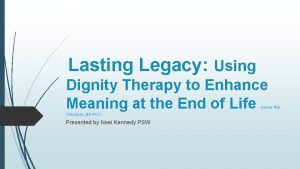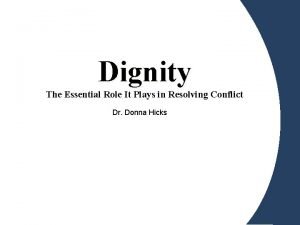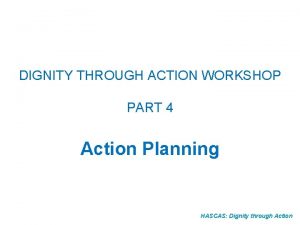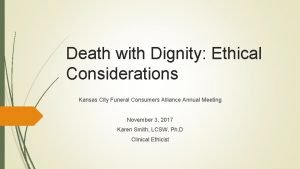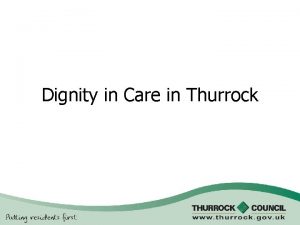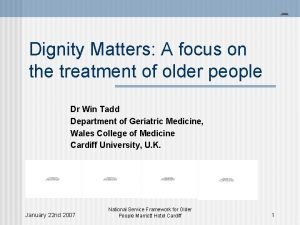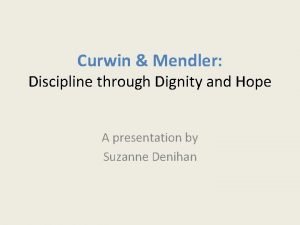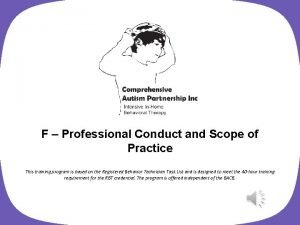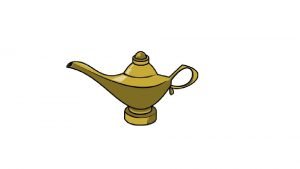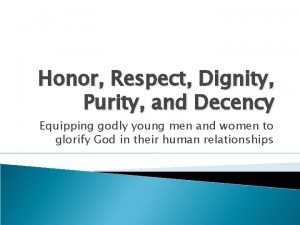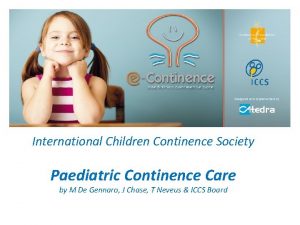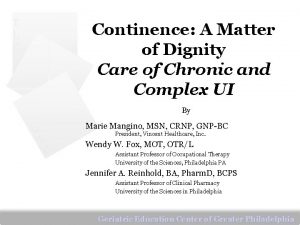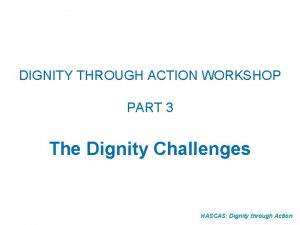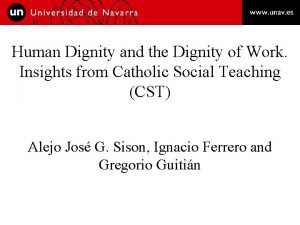Continence A Matter of Dignity T L C




































- Slides: 36

Continence: A Matter of Dignity T L C Causes, Signs and Prevention L T By C Marie Mangino, MSN, CRNP, BC President, Vincent Healthcare, Inc. Consultant, Penn Nursing Consultation Service © 2006 University of Pennsylvania Delaware Valley Geriatrics Education Center

T L C Acknowledgements Appearing in Video: Name L T C Appearing as Bob Swensen………. Mr. Banks Ruth Alpert…………Mrs. Banks Susaye Lawson…… Susaye Nate Lazowick……. Mr. Williams Kevin Brown……… Carl, DCSW Dinnie Childs………Piano Player Clarese Herbert……Mr. William’s friend Man at Piano………Arjun Bhojwani Nancy Web…………Mrs. Powell Eric Stewart………. Mike, grandson Ruth Livikoff………Ruth, DCSW Name Appearing as Dick Brown………………Mr. Clark Deanna Penn……………. Supervisor Sangeeta Bhojwani……. Trainee Roby Jacobs……………. . Daughter Charlene Duff……………Shopper, Gift Shop Sheila Mitchell-Ayers…Shopper, Gift Shop Marie Mangino…………. Trainer, as herself Tanisha Jones……………Testimonial Julie Cohlmer……………. Testimonial © 2006 University of Pennsylvania Delaware Valley Geriatrics Education Center

T L C Special thanks to: L T C • Henrietta Roberts and Sandy Bailey, of Stapeley in Germantown for coordination of video shoot • All the residents and staff of Stapeley in Germantown, for their participation and for permitting video production. • Raybourn Rusk Productions © 2006 University of Pennsylvania Delaware Valley Geriatrics Education Center

T L C Introduction L T C © 2006 University of Pennsylvania Delaware Valley Geriatrics Education Center

T L C Urinary Incontinence (UI) Defined L T C UI is simply defined as the involuntary or inappropriate loss of urine. In other words, incontinence is urine loss which happens when the person doesn’t want it to or doesn’t know it’s happening. © 2006 University of Pennsylvania Delaware Valley Geriatrics Education Center

Learning Objectives T L C q q L q T C q At the end of this program you will be able to: List the common causes of urinary incontinence (UI) Describe the potentially serious effects of not treating UI Recognize signs of a urinary tract infection Discuss effective ways to prevent or reduce episodes of UI and enhance dignity Our goal is to help you provide care to reduce or prevent episodes of UI and enhance the dignity of those in your care. © 2006 University of Pennsylvania Delaware Valley Geriatrics Education Center

Prevalence of UI T L C q 13 L T C million Americans have UI q 85% of them are women q Almost 30% of persons over 65 and living in the community have UI q 53% of homebound have UI q 50 -80% of LTC residents have UI In 8 of 10 cases symptoms can be improved and function restored. © 2006 University of Pennsylvania Delaware Valley Geriatrics Education Center

T L C The Facts about UI Continence is normal; Incontinence is not q Normal aging does not always cause incontinence q When continence is impaired, many simple things can be done to restore or improve function q L T C Mrs. Mendoza © 2006 University of Pennsylvania Delaware Valley Geriatrics Education Center

T L C Caring for UI is Important Because: q Untreated or under-treated UI can cause: § L T § Skin breakdown and infection Falls and injuries C Mr. Phillips © 2006 University of Pennsylvania Delaware Valley Geriatrics Education Center

Caring for UI is Important Because: T L C q Untreated or under treated UI can cause: § L T § C § Depression/social withdrawal Loss of dignity/lower quality of life UTIs (urinary tract infections) hospitalization death © 2006 University of Pennsylvania Delaware Valley Geriatrics Education Center

T L C Left Kidney Right Kidney L Ureters T C Structure of the Urinary Tract System Urethra Bladder wall muscle by Nicole Mangino 2004 © 2006 University of Pennsylvania Delaware Valley Geriatrics Education Center

T L C Contributors to UI: Age-Related Changes q Overactive L T C bladder muscle q Enlarged prostate (BPH) q Atrophic vaginitis and urethritis q Reduced bladder capacity q Increased post-void residual (PVR) © 2006 University of Pennsylvania Delaware Valley Geriatrics Education Center

T L C Contributors of UI: Injury and Disease q Diabetes q Damage L T C to the: Brain, Spinal Cord and Bladder Injury Mrs. Banks © 2006 University of Pennsylvania Delaware Valley Geriatrics Education Center

T L C Contributors to UI: Limitations in Function q Ambulation L q Dressing T C Mr. Williams © 2006 University of Pennsylvania Delaware Valley Geriatrics Education Center

Contributors to UI Bladder Irritants T L C q Artificial L T sweeteners q Caffeine q Alcohol C Mrs. Powell © 2006 University of Pennsylvania Delaware Valley Geriatrics Education Center

T L C Contributors to UI Hydration & Physical Conditions q Not L T C enough fluid q Too much fluid q Fecal Impaction q Acute Confusion q Infections/Medical illness © 2006 University of Pennsylvania Delaware Valley Geriatrics Education Center

T L C UTI Symptoms in the Older Adult q Increased L T C Frequency q Increased Urgency q New or increased incontinence q Urine odor or cloudiness q Change in mental status © 2006 University of Pennsylvania Delaware Valley Geriatrics Education Center

Acute Changes in Mental Status that may indicate UTI T L C q Sleepiness q Lethargy L T q Irritability C or agitation q New or increased confusion Mr. Green © 2006 University of Pennsylvania Delaware Valley Geriatrics Education Center

T L C Things You Can Do for Older Adults with UI q Keep L a log of UI events q Monitor toileting T C © 2006 University of Pennsylvania Delaware Valley Geriatrics Education Center

T L C Things You Can Do for Older Adults with UI q Determine L T C frequency of need q Develop a schedule and prompt © 2006 University of Pennsylvania Delaware Valley Geriatrics Education Center

The Banks’ Turning Point T L C L T C © 2006 University of Pennsylvania Delaware Valley Geriatrics Education Center

Things You can Do: Scheduling T L C q Log L T C actual number of “accidents” or “urinations” q Based on log results develop schedule q Establishing and following a schedule can give a person confidence to do other things © 2006 University of Pennsylvania Delaware Valley Geriatrics Education Center

T L C Things You Can Do Encourage change in diet (avoiding caffeine, sweeteners, alcohol) q Assist with § getting to the bathroom or commode § removing clothing § positioning urinal or bedpan q L T C © 2006 University of Pennsylvania Delaware Valley Geriatrics Education Center

Mr. Williams’ Challenge T L C L T C © 2006 University of Pennsylvania Delaware Valley Geriatrics Education Center

Mr. Williams’ Challenge T L C q Arthritis q Personal L T C Embarrassment q Effect on Family q Clothing with Elastic or Velcro Closures © 2006 University of Pennsylvania Delaware Valley Geriatrics Education Center

T L C Things You Can Do q Make L T C urinals available to men q Prompt (suggest, encourage and remind) to toilet q Encourage and motivate q Change if incontinent Mr. Samson © 2006 University of Pennsylvania Delaware Valley Geriatrics Education Center

T L C Skin Care To prevent skin breakdown: q q L T C q q Work towards improved continence Change incontinent garments promptly and clean perineum and buttocks Use a skin barrier Promptly report any change in skin © 2006 University of Pennsylvania Delaware Valley Geriatrics Education Center

T L C Product Use for UI q q Least restrictive Most dignified Brief (diaper) § Regular underwear with liner § Change type of clothing used to reduce time § L T C © 2006 University of Pennsylvania Delaware Valley Geriatrics Education Center

T L C Final Case Scenario • L • T C Ms. Hill has rheumatoid arthritis with severe deformities of her hands She has difficulty with such things as door knobs and buttons on her clothes Mrs. Hill © 2006 University of Pennsylvania Delaware Valley Geriatrics Education Center

Learning Objectives Review T L C Can you now: L T C 1. List the common causes of Urinary incontinence (UI)? 2. Describe the potentially serious effects of not treating UI? 3. Recognize signs of a UTI? 4. Discuss effective ways to prevent or reduce episodes of UI and enhance dignity? © 2006 University of Pennsylvania Delaware Valley Geriatrics Education Center

Special Thanks To: T L C Christine W. Bradway, Ph. D, CRNP Assistant Professor of Gerontologic Nursing University of Pennsylvania School of Nursing L T C Mary Ann Forciea, MD Clinical Associate Professor of Medicine Director, Primary Care Services University of Pennsylvania Health Systems Nicole Mangino Illustrator © 2006 University of Pennsylvania Delaware Valley Geriatrics Education Center

T L C References and Resources Burgio, K. L. , Robinson, J. C. & Engel, B. T. (1986). The role of biofeedback in Kegal exercise training for stress urinary incontinence. American Journal of Obstetrics & Gynecology, 154: 58 -64. L • Choe, J. M. (1999). Freedom regained: Female urinary incontinence can be overcome. Columbus, Ohio: Anadem Publishing; 117 -171. T C • Clinical practice guideline number 2: Urinary incontinence in adults. Rockcville Md: US Department of Health and Human Services Agency for Health Care Policy and Research; 1996. AHCPR publication 96 -0682. • Gibbons, L. & Choe, J. M. (2005). Helping women quell urinary incontinence. The Clinical Advisor, 7 (5), 21 -28. © 2006 University of Pennsylvania Delaware Valley Geriatrics Education Center

T L C References and Resources Langa, et al, (2002). Informal caregiving time and costs for UI in older individuals in the US. Journal of the American Geriatrics Society, 50, (4): 733 -737. Lee SY, Phanumus D. & Fields S. D. (2000). Urinary incontinence: a primary care guide to managing acute and chronic symptoms in older adults. Geriatrics, 55(11): 65 -72. L T C Morkved, S. Bo, K. & Fjortoft, T. (2002). Effect of adding biofeedback to pelvic floor muscle training to treat urodynamic stress incontinence. Obstetrics & Gynecology, 100; 730 -739. Multiple authors (2004). Special issue: Urologic care of the older adult. Urologic Nursing, 247 -333. Teunissen, T. A. M. , de Jonge, A. , van Weel, C. , & Lagro. Janssen, A. L. M. (2004). Treating UI in the elderly— conservative measures that work: A systematic review. Journal of Family Practice, 53 (1), 25. © 2006 University of Pennsylvania Delaware Valley Geriatrics Education Center

T L C References and Resources Web sites: Collaborative to Support Urinary Incontinence and Women’s Health www. stress. UI. org L T National Association for Continence: www. nafc. org C National Institute of Diabetes & Digestive & Kidney Diseases: www. niddk. nig. gov © 2006 University of Pennsylvania Delaware Valley Geriatrics Education Center

Leadership and Staff: T L C L T C Kathleen Egan, Ph. D Series Editor DVGEC Program Administrator Director, DVGEC University of Pennsylvania Lois K. Evans, DNSc, RN, FAAN Series Associate Editor Viola Mac. Innes Independence Professor School of Nursing University of Pennsylvania Mary Ann Forciea, MD Series Associate Editor Clinical Associate Professor of Medicine Division of Geriatric Medicine, University of Pennsylvania Sangeeta Bhojwani Associate Director, Series Assistant Editor DVGEC University of Pennsylvania Laura Raybourn Sally Rusk, Consultants Raybourn Rusk Productions © 2006 University of Pennsylvania Delaware Valley Geriatrics Education Center

T L C L T C “Continence: A Matter of Dignity Care of Chronic and Complex UI” is designed to follow this module (what you have learned in “Causes, Signs & Prevention”). © 2006 University of Pennsylvania Delaware Valley Geriatrics Education Center
 Classification of matter section 1 composition of matter
Classification of matter section 1 composition of matter Gray matter and white matter
Gray matter and white matter Chapter 2 section 1 classifying matter answers
Chapter 2 section 1 classifying matter answers Matter
Matter Section 1 composition of matter
Section 1 composition of matter Median and lateral apertures
Median and lateral apertures Energy naturally flows from warmer matter to cooler matter
Energy naturally flows from warmer matter to cooler matter Gray matter
Gray matter Classification of matter section 1 composition of matter
Classification of matter section 1 composition of matter Lasting legacy meaning
Lasting legacy meaning Dignity its essential role in resolving conflict
Dignity its essential role in resolving conflict What is human rights
What is human rights Human dignity questions
Human dignity questions Two households alike in dignity
Two households alike in dignity Open disclosure in aged care
Open disclosure in aged care Step 4 examples
Step 4 examples Dignity at work policy
Dignity at work policy Questions about human dignity
Questions about human dignity To upkeep the honour and dignity of the
To upkeep the honour and dignity of the Dignity kansas city
Dignity kansas city Definiton of dignity
Definiton of dignity How do i get feedback with grace and dignity
How do i get feedback with grace and dignity The dignity challenge
The dignity challenge What is human dignity
What is human dignity Code of ethics for professional teachers article 2
Code of ethics for professional teachers article 2 Visual design principles and elements matrix
Visual design principles and elements matrix The dignity in care campaign
The dignity in care campaign Why is dignity important
Why is dignity important Two households, both alike in dignity
Two households, both alike in dignity Curwin and mendler discipline with dignity
Curwin and mendler discipline with dignity Client dignity rbt examples
Client dignity rbt examples Romeo and juliet prologue translation
Romeo and juliet prologue translation Two households end
Two households end A virtuous woman proverbs 31 niv
A virtuous woman proverbs 31 niv Dignity and discipline
Dignity and discipline Dignity champion badge
Dignity champion badge Modern romeo and juliet prologue
Modern romeo and juliet prologue









